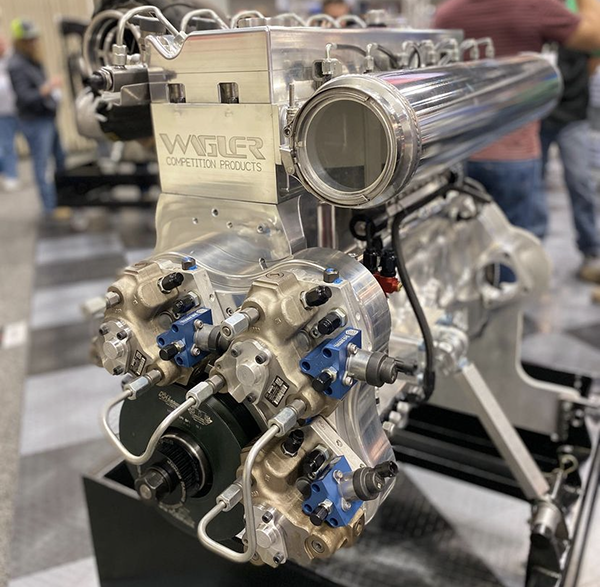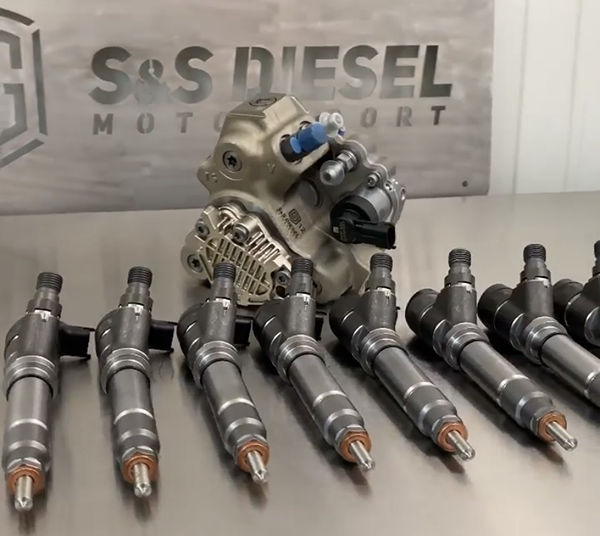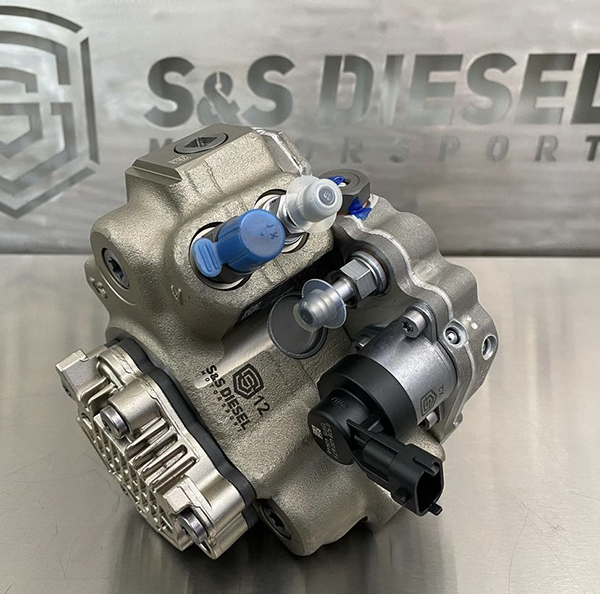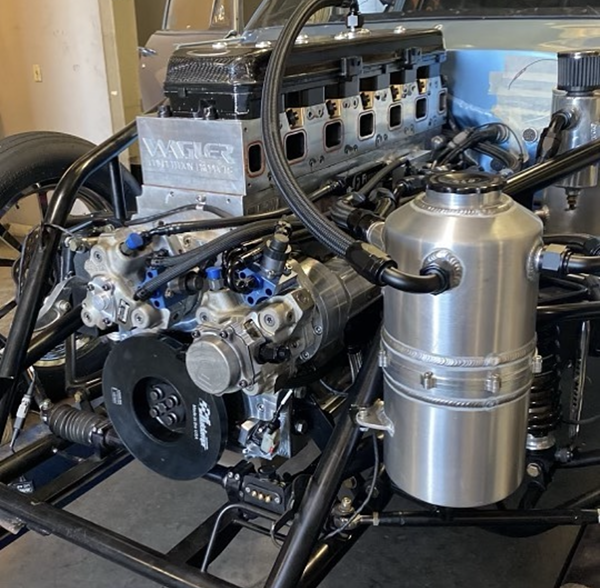It’s no secret to all you engine builders and diehard enthusiasts that air and fuel are two very important factors for performance, especially in the diesel world these days. Recently, I came to find out that you don’t truly know just how important something like your fuel system is until you sit down and chat with a guy like Lavon Miller of Firepunk Diesel. I recently did just that and got schooled on all things fuel systems and injector combinations, so I could pass along that great info to all you diesel fanatics.
Click Here to Read More
The secret sauce for getting everything you can out of your engine lies in the fuel system. It’s the heart of a diesel. Make more air, need more fuel, and you make more power. Lavon and Firepunk Diesel have been playing this high-performance game since 2005, when for them, it started as a hobby. In 2009, it became a business, and today, Firepunk is synonymous with trend-setting diesel innovation and helping others achieve their goals and dreams inside a truck.

Firepunk Diesel has many capabilities, but fuel systems and the data behind what works and what doesn’t has become something Lavon and his team have mastered. Before we dive into the specifics, there’s an important piece of info everyone should know.
“Good, clean fuel is very important in a common rail system,” Miller says. “All it takes is a little piece of dirt that’s two microns to start causing damage in the internal control rod of the injector body. A lot of guys come from the mentality of the old-school P-pumps where you could pretty much put vegetable oil in your fuel tank and it’ll run. The new common rail systems are a lot fussier. Good quality fuel, good filtration and good lubricity is key.”
Fuel treatments and additives can help keep your fuel in top shape, but when it comes to getting your fuel system operating at peak performance, it’s all about better fuel pressure, better spray patterns, atomizing fuel, and making heat. That’s where the power is made.
In dissecting a typical diesel fuel system, there’s really three main components – the injector, the high-pressure fuel pump or CP3, and the lift pump. A stock fuel system in a 325-hp diesel engine with an aftermarket turbo, can make 550 hp by maxing out the stock fuel system. As you increase injector size, you’re increasing your nozzle flow.

“A lot of people go from a stock flow injector to 60{09e594db938380acbda72fd0ffbcd1ef1c99380160786adb3aba3c50c4545157} over, 100{09e594db938380acbda72fd0ffbcd1ef1c99380160786adb3aba3c50c4545157} over, 200{09e594db938380acbda72fd0ffbcd1ef1c99380160786adb3aba3c50c4545157} over, up to 400{09e594db938380acbda72fd0ffbcd1ef1c99380160786adb3aba3c50c4545157} over depending on what your end power goal is,” Miller says. “A lot of the UCC guys are running between 400{09e594db938380acbda72fd0ffbcd1ef1c99380160786adb3aba3c50c4545157} and 600{09e594db938380acbda72fd0ffbcd1ef1c99380160786adb3aba3c50c4545157} over injectors. Obviously, you need a CP3 pump that can support it. The CP3 pump, depending on your injector size and your rpm, will depend on how much pump you need.
“It’s a whole can of worms when you start talking about this stuff, because we’re finding a big difference between if you run a large injector, say a 500{09e594db938380acbda72fd0ffbcd1ef1c99380160786adb3aba3c50c4545157} over, and then you keep your injector pulse width short. The CP3 has more time to recover rail pressure in between injector cycles from one injector to the next. The same CP3 can support more power with a bigger injector than it can with a smaller injector and having injector pulse width stretched way out. The next injector is firing before the other one is shut off and the CP3 has a lot harder time recovering rail pressure.”
As time has gone on, injectors have gotten bigger, injector pulse width and the tuning has remained shorter, and the diesel industry has figured out how to make engines as efficient as possible to where more horsepower can be made with the same fuel quantity as before – just add nitrous or increase your air/fuel ratio. Diesel engines can make significantly more power by leaning them way out.
“What we were doing with our billet motor when we were on the engine dyno is we set the engine to 300 milligrams of fuel,” Miller says. “We made 1,390 horsepower at 300 milligrams of fuel with a 91mm turbocharger. Then, we started adding nitrous without changing fuel, which is akin to adding air, so it changed our air/fuel ratio. We started at about 17:1 air/fuel ratio on fuel, then added a kit of nitrous and picked up 100 horsepower. We ended up adding nitrous until we got to 1,970 horsepower with the same fuel quantity. All we did was go from 17:1 air/fuel ratio all the way to 30:1. That same 300 milligrams of fuel that the fuel system was delivering in a street truck might have made you think the pump and injectors were maxed out at 1,390 horsepower. But, if you add the correct air/nitrous setup, that same 300 milligrams of fuel would support over 1,900 horsepower.”
Firepunk repeated the same test on a completely stock truck with an aftermarket turbo and maxed the fuel system out. It made 549 horsepower. Then, they added nitrous and more nitrous until it made 905 horsepower – still utilizing the stock injector, stock CP3 and stock lift pump.

“You’re using the same fuel quantity, but you’re being a lot more efficient with your fuel,” he says. “You’re actually burning that fuel. The nitrous is just making sure that there’s a lot of oxygen-rich air in there, and it’s going to burn every little bit of fuel in there.”
Lavon admits this isn’t necessarily safe on a stock truck. On a stock fuel system, you have the injector pulse width stretched out to 3,000 microseconds, so the injector on time is pretty long and you’ve got fire on your piston for quite a bit of that time. As long as your engine rpms are not too high – under 4,000 rpm – you’re probably alright doing that for a couple runs. But, if you run that high injector pulse width to 4,500-5,000 rpm, you’re almost certain to melt a piston.
“For that reason, if the goal was 900 horsepower, we would generally go to at least a 100{09e594db938380acbda72fd0ffbcd1ef1c99380160786adb3aba3c50c4545157} over injector to cut the injector pulse width back to 1,800-1,900 microseconds,” he says. “That would be closer to the stock injector pulse width and you get the fuel quantity delivered in the same window of time. You’re getting more fuel in before top dead center and your piston crown temperature will not get as hot because you’re not spraying high-pressure fuel on the piston for as long of a time, every time the injector fires.”
Of course, much like horsepower numbers, people get wrapped up in injector sizes, but the CP3 pump is also a critical component to consider.
“A factory CP3 has a stroke of 8.2mm,” Miller says. “The common CP3s have a 10mm, 12mm and 14mm stroke. A lot of the manufacturers of the high-pressure CP3s are not willing to increase the bore size of the CP3 because Bosch has done such a fine job of making the bore-to-piston clearance so tight that the aftermarket world can almost not match it. That’s why, in the aftermarket world, you see Exergy and S&S and the reputable fuel system companies just modifying the cam and increasing stroke in the CP3s to increase fuel volume.”

If you’re looking to upgrade your fuel system, Lavon says selecting an injector first is usually the better way to go.
“Nine times out of 10, the injector comes first.,” he says. “You can always put a bigger injector in and with the custom tuning that’s available, you can dial the injector back until your stock CP3 can keep up. You’ll still see a gain. A stock CP3 might only able to support 550 horsepower worth of fuel with the stock injector until it’s maxed out. Well, now you go to a 100{09e594db938380acbda72fd0ffbcd1ef1c99380160786adb3aba3c50c4545157} over injector and cut your injector pulse width from 3,000 microseconds down to 2,000 microseconds, and the CP3 has more time to rebuild rail pressure in between injector strokes. That same CP3 that was maxed out at 550 horse will support 650 horsepower worth of fuel just by shortening the injector pulse width.
“That’s why we generally have guys do the injector first and buy the injector size that fits their final peak power goal. We only change injector size based on peak power goals. Once they can financially recover from that, then they can put a pump on it. From there, you can retune it and turn the rest of the fuel quantity up and actually get the fuel quantity they want in the end if they can’t afford to do both at the same time.”
As mentioned, just a few years back when injectors and pumps weren’t as good as they are today, people thought multiple CP3 pumps were the answer to more fuel. Lavon and Firepunk used to run three CP3s back in 2016. Today, CP3 technology has gotten a lot better.
“Companies like Exergy have a 14mm race pump, and two race pumps at 5,500 rpm will flow enough fuel for 3,000 horsepower,” he says. “The number of CP3s needed depend on your goals, but generally we look at total milligrams of fuel delivered. We figure out how much fuel quantity we need per horsepower, and then we calculate, based on wanting to make 2,500 horsepower, you’ll need two pumps. We’ve made over 2,000 horsepower with a single 14mm CP3 with 100{09e594db938380acbda72fd0ffbcd1ef1c99380160786adb3aba3c50c4545157} over injectors and three stages of nitrous.”
Obviously, not every diesel truck owner can have or necessarily wants to make 2,000 horsepower-plus. For that reason, Firepunk has several suggested fuel system levels for street truck customers to all out race setups.

“The most common builds would be in the 800-900 horsepower range, because that is about as much as you can get without doing bottom end work,” Miller points out. “The phone rings most often with guys who don’t want to pull the motor and put rods in it. They want to be able to use bolt-ons and make as much power as they want without having to dig into the engine. A very common setup is to go with a 12mm stroker pump, a 100{09e594db938380acbda72fd0ffbcd1ef1c99380160786adb3aba3c50c4545157} over injector, and an S472 turbo to get an 850-horsepower street truck.
“The next step would be guys who take a stock motor and pop the pistons and rods out of it for billet rods and throw the stock pistons right back in. They upgrade the head studs and go to a 250{09e594db938380acbda72fd0ffbcd1ef1c99380160786adb3aba3c50c4545157} over injector with a 14mm pump. They can run a set of compound turbos – a 468 over a 488 compound set up – and have a 1,200-horsepower street truck. That would be the second most-common street truck platform we see.
“Beyond that, a very common setup we’ve been putting in a lot of race trucks is a single 14mm race pump with 400{09e594db938380acbda72fd0ffbcd1ef1c99380160786adb3aba3c50c4545157} over injectors. You can either run a big set of compounds or you can run a single turbo with a couple kits of nitrous. That combo can make anywhere from 1,350-1,800 horsepower pretty consistently, depending on what your air setup is.”
As with any engine upgrade or component purchase, the best advice is to do it right the first time around, and Lavon agrees.
“With diesel fuel systems, it’s pay now or pay later,” he says. “I see a lot of guys put bigger nozzles on worn-out stock injectors and they may be getting a late end of injection and not even know it. I would always recommend that if you are putting nozzles on a set of injectors to have them sent to a reputable fuel system shop and have them flowed and tested, just to make sure that you don’t have a problematic injector before you put it in your truck and cost yourself an engine.” EB